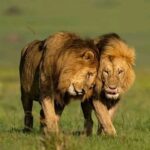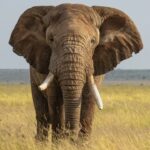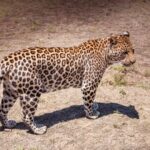The term “Big Five” originally referred to the five most difficult animals to hunt on foot in Africa, coined by big game hunters in the early 20th century. These formidable creatures—lion, leopard, elephant, rhinoceros, and buffalo—were not only challenging to track and hunt due to their size and strength, but also posed significant danger to the hunters. Today, the Big Five are among the most sought-after sightings for wildlife enthusiasts and photographers visiting Africa, symbolizing the rich biodiversity and natural beauty of the continent.
1. The Lion
Known as the “King of the Jungle,” the lion (Panthera leo) is a majestic predator renowned for its powerful build, majestic mane and impressive roar, which can be heard up to five miles away. Lions live in prides consisting of several females, their cubs and a few dominant males. In Kenya, the Maasai Mara National Reserve is one of the best places to witness these magnificent creatures, especially during the Great Migration, when millions of wildebeest and zebras cross the plains, followed closely by predators.
2. The Leopard
The elusive and solitary leopard (Panthera pardus) is the most difficult of the Big Five to spot due to its nocturnal habits and excellent camouflage. Leopards are known for their ability to adapt to various habitats and their strength, which allows them to haul their prey up into trees to avoid scavengers. The Laikipia Plateau and Samburu National Reserve are prime locations in Kenya to catch a glimpse of this stealthy feline, often seen lounging on tree branches or rocky outcrops.
3. The Elephant
The African elephant (Loxodonta africana) is the largest land animal on earth, known for its intelligence, strong family bonds and distinctive tusks. Elephants are social animals that live in matriarchal herds and are often seen migrating across vast distances in search of food and water. Amboseli National Park, with the stunning backdrop of Mount Kilimanjaro, is one of the best places in Kenya to observe these gentle giants in their natural habitat.
4. The Rhinoceros
Rhinoceroses, both black (Diceros bicornis) and white (Ceratotherium simum), are critically endangered due to poaching for their horns. These prehistoric-looking creatures are known for their thick skin and formidable horns. The Ol Pejeta Conservancy in Kenya is a key sanctuary for rhino conservation and offers a rare chance to see both black and white rhinos, including the last two remaining northern white rhinos in the world.
5. The Buffalo
The African buffalo (Syncerus caffer) is a formidable and unpredictable animal, known for its large horns and strong herd instincts. Buffalos are considered one of the most dangerous animals in Africa due to their tendency to charge when threatened. They are commonly found grazing in large herds in savannas and floodplains. The Tsavo National Parks (East and West) provide ample opportunities to observe these powerful creatures in large numbers.
Conclusion
Encountering the Big Five in their natural habitats is a breathtaking experience that highlights the incredible diversity and resilience of African wildlife. Kenya, with its rich landscapes and well-protected national parks, offers some of the best opportunities to see these iconic animals up close. Whether you are tracking lions in the Maasai Mara, spotting leopards in Samburu, or witnessing the grandeur of elephants against the backdrop of Mount Kilimanjaro, each encounter with the Big Five is a reminder of the importance of wildlife conservation and the awe-inspiring beauty of nature.





